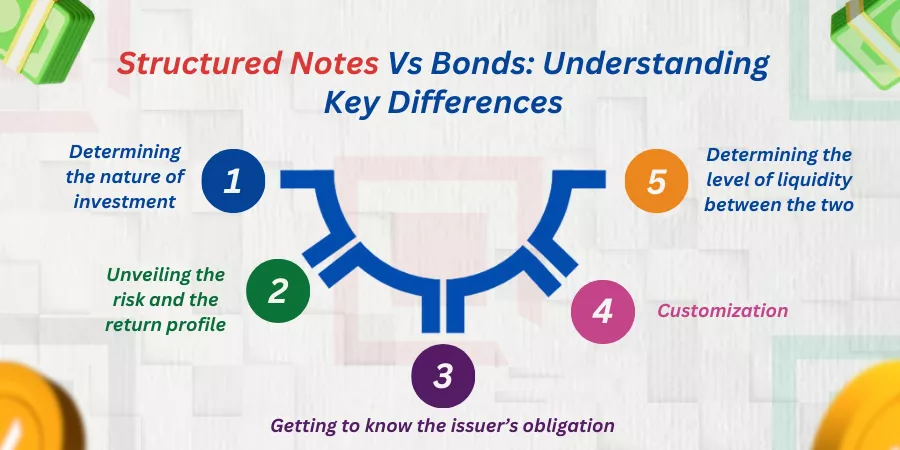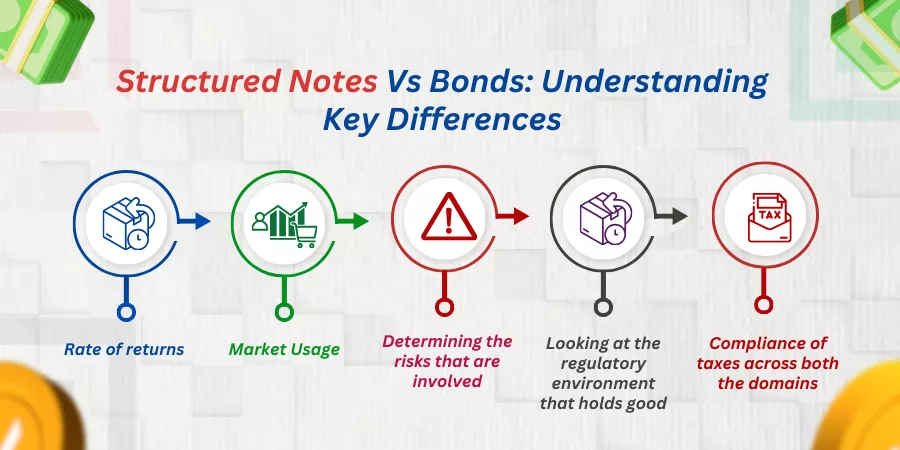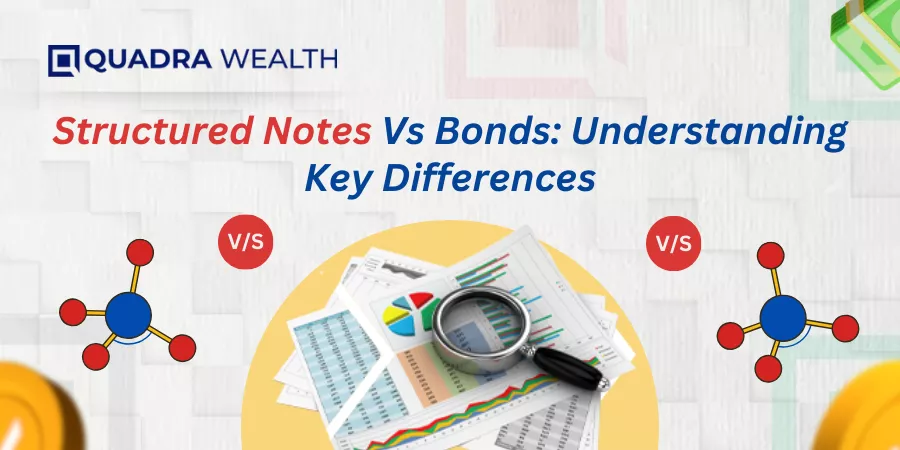Introduction
As a traditional investor, you must definitely love to invest in bonds that can comprise government-backed securities or mortgage deeds wherein you get fixed rates of returns in the form of interest earnings or coupon payments. You are also assured of a guaranteed return of your principal money at the end of the term period.
What if I had to tell you that you can get the very same level of cap protection with exposure to equities in the stock market? Well, these are hybrid securities for you named structured notes. Structured notes are hybrid securities that mix an optimum amount of bond and equity-related derivatives.
While the bond protects the capital amount of the investor to a greater extent, the assets provide a better rate of return to the investor by exposing a portion of the investor capital towards equity-related derivatives like high-paying shares, a basket of securities, commodities, futures, and currencies to name a few. Therefore, structured notes can provide you with the best of traditional investing and hybrid exposure to equity.
On this parlance, let us unveil the key points of differences covering Structured Notes Vs Bonds. Helping you get started on this:

Determining the nature of investment
Structured Notes are hybrid investments that combine debt and equity for investors to leverage on their wealth-building operative on a more comprehensive scale indeed. The notes comprise the promissory bond that protects the cap investment while the returns on investment are linked to the performance of underlying assets the notes are linked with. These assets can be equity derivatives, currencies, futures or market index products to name a few.
Whereas, with bonds, the structure is relatively a simpler one. The investor invests a sum of money in a product issuing firm. This can be a govt entity or a corporate financial center. The bonds garner a fixed rate of returns in the form of interest earnings as well as coupons that are paid to investors periodically. During the term period of bonds, the principal amount or the original investment amount gets repaid to the investor.
Unveiling the risk and the return profile
With respect to structured notes, the investors get variable returns on investment. This is because the returns on the notes are based on the performance of the underlying assets the notes are linked to. The payouts can also vary from one type of structured note to another. Investors have coupons, interest payments, and dividend earnings to name a few.
Whereas, with respect to Bonds, the returns are usually fixed rates of returns. The rate of investment is put up on your term offer letter or you get the info printed across your policy documents. The capital or the principal repayment happens at the end of the bond tenure.
Getting to know the issuer’s obligation
The structured note has a hybrid feature wherein you might opt for a fixed return profile from the product issuers. Otherwise, the note can be linked to the performance of underlying derivatives of the structured product that we are talking about. Therefore, the returns on investment are more of a variable one from the product issuer’s point of view.
Whereas, with respect to bonds, this is more of a fixed-return investment product. The rate of interest, investment amount, and the tenor period are mentioned on the agreement policy document or the offer letter you receive from the product issuing firm. The terms and conditions for bonds usually do not change and remain static for the investors.
Customization
Structured notes can be customized to suit every investor’s independent and tailor-made needs and preferences indeed. The product issuers discuss the risk tolerance ratio of every single investor and decide how much risk each investor handles under his belt. This way, you get the risk profiling done to suit the customized financial requirements of investors and design notes with assets accordingly. In a nutshell, it is only structured notes that enjoy a maximum level of customization in the world of investing.
Whereas, bonds do not offer any kind of scope with respect to customization. You may choose between government bonds, tax waiver bonds, or corporate-level bonds. And, the terms and conditions with respect to the investment amount, the term period, and the rate of interest are decided by financial houses and product issuing firms. Investors have little say on how the bonds are monitored in the market. Therefore, bonds do not offer any kind of customization to lend investors a tailor-made approach as far as investing is concerned.
Determining the level of liquidity between the two
Structured notes are not very liquid in nature. This is because the notes are independently curated for every investor keeping his tailormade financial goals or objectives in mind. What suits one may not fit the needs of the other. Therefore, it is quite difficult to sell the notes in case of a distress situation.
However, the investors can return the notes to the product issuing firms if they have an urgent need for the money. Otherwise, they can sell the notes in smaller bifurcations in the secondary markets. But, one cannot exactly determine if that sum would match the initial principal amount that is invested by the investor on procuring such notes from the primary marketplace.
Whereas, with respect to bonds, the liquidity of the investment is really good as you can easily sell them across secondary markets at a profitable value. Traditional investors like retirees, pensioners, or conservative retail investors would always want to buy bonds as they lend complete cap protection and offer stable returns on the investment. Therefore, bonds are highly liquid in nature.

Rate of returns
The returns structured notes offer can be highly dynamic and variable. This is because the returns on investment for structured notes are always based on the performance index of underlying assets that are linked to the notes. The returns can also be capped by product issuers thereby limiting the upside profit sharing of investors as against direct forms of investments on the same equity products.
Whereas, with respect to bonds, investors receive fixed interest payouts or floating coupons as stated on the policy documents or offering letters. The returns on investment with respect to bonds are therefore more stable and predictable.
Market Usage
Structured notes are usually ventured into by sophisticated investors who are veterans in the field of managing their investments or finances. This is primarily because you must know how to foresee your investment portfolios under specific market conditions. And, this comes with years of experience in the field of managing your investment portfolios effectively.
Whereas, bonds can be utilized even by newbie investors or amateurs because the structure of this particular investment option is easier to learn or understand. You get fixed or floating coupons or interest payments throughout the term of the asset while you also get your principal cap done by the end of the term period of the investment plan.
The investment option is primarily used by risk-averse or traditional investors like pensioners, retirees, and retail investors who belong to an old school of thought.
Determining the risks that are involved
Structured notes are subject to the credit risk of the product issuing firm. Here, if the product issuer falls bankrupt or signs up for liquidation, then investors are more likely to lose a significant portion of their capital wallet. The notes are also subject to market risks. If the underlying assets of the notes do not perform well in the market, then investors can lose a partial or even a complete portion of their capital wallet.
Whereas, with bonds, this is a kind of investment option that is relatively a safer bet for investors. The investors get their principal investment plus returns in most cases. However, bonds are also subject to credit risk wherein if the product issuing firm goes bankrupt or gets busted, then investors face a potential risk of losing a partial or entire value of their cap wallet.
Looking at the regulatory environment that holds good in both domains
The notes are subject to regulatory intervention from govt agencies, private wealth management consoles, and even investment-grade banks. However, if the notes are offered by independent practitioners, investors might not have that much of a regulatory intervention for the managing of stuff on the whole.
Whereas, with respect to bonds, the product issuance firms are subject to stringent norms as laid down by government-aided regulatory authorities or by nationalized banks as such. Here, the investor’s interest is protected to a greater extent indeed.
Compliance of taxes across both the domains
The tax implications for structured notes can be quite complex to learn or understand. This is primarily because you might have different types of tax implications the tax authorities levy on interest earnings, coupons, or capital-based dividend earnings. You must get proper guidance from a tax advisor and learn how tax implications can affect your earnings on structured notes.
Whereas, with respect to bonds, the tax implications are more straightforward in nature. Here, the bonds provide fixed as well as floating coupons that are interest earnings on various types of govt bonds, mortgage deeds, real-estate equities, or corporate bonds that are entirely capital protected. The govt also produces tax waivers on bonds from time to time.
The Bottom Line
To finally summarize, structured notes are more complex products that combine debt, as well as derivative components within their structural, outlays. Then, you have customized risk profiling with complex risk-return nomenclatures while with bonds these are simpler investment options that protect the capital investment of investors and also provide them with more stable and predictable rates of return. What are your thoughts on this? Do mention it in the comments below!
Frequently Asked Questions or FAQs
Are structured notes deemed as income notes?
Answer: Structured notes may be dubbed as income notes because they provide fixed coupon payouts or interest earnings on capital-protected products. On the contrary, the notes also comprise equity indexed assets. Therefore, the potential returns on investment may be linked to the performance of the underlying assets of the notes. The notes therefore can be utilized as growth notes too.
How return is based on structured notes?
Answer: The maturity or the return on investment is based on the performance of underlying assets the notes are linked with. The investors are therefore also exposed to downside risks of equity spread to a certain extent.
However, the rewards can also be phenomenal on notes linked to etfs or equity. Whereas, with respect to treasury bonds, the pricing, interest rates and term period remain static or unchanged in nature






